The Libretto W100 is basically an oversized Nintendo DS that runs on Windows 7 Home Premium. It’s neither a netbook nor a tablet, but can be misconstrued as one or the other as it houses two 7-inch screens that fold into a clamshell.Enjoy Toshiba Libretto W100………
Toshiba has a history of interesting world firsts, and here’s another one — a dual touchscreen laptop running Windows 7. It’s called the Libretto W100, and CNET UK was on hand at the product announcement to take photos and deliver our professional considered opinion. We also had cupcakes.
Toshiba’s also today announcing the Libretto W100. It’s a full Windows dual-screen “ultra-mobile PC” that’s not quite a tablet and not quite a netbook. In short: it’s one curious little gadget.
Toshiba’s dualscreen laptop of sorts is real, and it’s exactly what you’ve inevitably been staring at right up there. In celebration of the 25th anniversary of the company’s laptop business, Tosh gave its classic Libretto ultraportable brand some mouth-to-mouth with the W100. Yeah, we couldn’t believe it ourselves when we saw it, but the device certainly is legit — it has two 7-inch, 1024 x 600-resolution touchscreens, and is powered by a 1.2GHz Intel Pentium U5400 processor, 2GB of RAM, a 64GB SSD and Windows 7 Home Premium.
The 1.2-inch thick Libretto W100 is covered in a black brushed aluminum finish, and is surrounded by a single USB port, an SD card reader and headphone jack. We’re not entirely sure how we feel about the design and the logo on its cover, but it’s still a darn cute little laptop, and at 1.8 pounds it felt quite light in our hands. We caveat this by saying that the model we saw a few weeks ago was an early pre-production unit, but it was running quite warm and the fan noise was extremely noticeable. We’re not sure why Tosh went with an Intel ULV processor instead of an Atom here — we expect the endurance even with its six-cell to be less than four hours.
The concept of a dual-screen device has been attempted several times, but the W100 is easily one of the smallest. There’s the top half, which serves as your primary screen, and then there’s the bottom half, which is multipurpose: You could use it as a second screen, extend the primary screen, or type on it with Toshiba’s home-brewed virtual keyboards.
The last part had to be the toughest, as Toshiba created a custom user interface from scratch. Bear in mind, the W100 doesn’t have a physical keyboard or dedicated mouse buttons. The device is basically made up of two touch screens and three physical buttons—one for Power, a Home key, and a button that cycles through six different virtual keyboards. The screens use Haptic technology, which means there’s force feedback with each virtual key pressed.
Toshiba included a basic QWERTY keyboard, which is laid out like the one on the Apple iPhone. The full version made it so that the keys are smaller than the basic one, but you have every key at your disposal. The split keyboard seemed the most user-friendly, since I’m accustomed to thumb-typing on my iPhone. And there are versions that emulate a phone and numeric keypad. Overall, I found the keyboard experience very difficult to grasp although, similar to my first iPhone experience, I’m sure it gets better with time.
For those who spend a lot of time Web surfing, the user interface also has a virtual touchpad and mouse buttons, which worked quite well during my time with the W100. When the virtual navigation tools are not in play, the split screens can be treated as one for very long pages, or used for two separate application windows. Though I didn’t try it as one, the W100 seems like a slam dunk for e-book readers, since the device can be held like a book.
When shut, the W100’s two touchscreens align more or less perfectly, giving the whole device a very small footprint — it measures only 202 millimetres across. It’s still too big to fit in a pocket, however — you’ll need a bag with you if you want the W100 to accompany you on your travels.
The W100’s lid rocks a brushed aluminium finish. There’s no info yet on whether other colours will be available, but this black version was looking pretty snappy
We didn’t experience this with the standard Windows software that was pre-loaded, but it’s something to bear in mind if you plan to install software with small menus, such as iTunes.
However, productivity could still be a challenge for those who prefer to type on an actual, physical keyboard than a touchscreen. There is a single USB 2.0 port if you want to connect your own, but that defeats the purpose of easier portability.
It’s also extremely light — Toshiba reckons the W100 weighs 819g. As the above image shows, it’s a little light when it comes to ports, with nothing visible on the right-hand side except the power input.
The Libretto W100 isn’t exactly slim, but you should take this slightly chubby-looking photo with a pinch of salt. At 33.4 millimetres, it isn’t that thick in relative terms, but being not very wide does leave it with a comparatively stocky frame.
As you can see, Toshiba has made a few modifications of their own to the windows taskbar. A selection of touch-activated shortcut buttons are along the bottom, designed to make navigating the full touch interface a little smoother.
The lower panel will mostly be used for typing — and our first impressions are that actually tapping stuff out on the W100 is… learnable. Admittedly, we stumbled a few times early on, but from our initial demo we got the impression that a little patience would pay off. That’s something we’ve seen when it comes to typing on the iPad certainly.
There’s a built-in sensor that knows when the W100 has been flipped on its side, at which point the display re-arranges itself thus. Thanks to the complex nature of the Windows 7 operating system, this transition isn’t as smooth as that you’d see on an iPad (which rocks a much more basic operating system) but it gets the job done, and if you don’t mind a bit of fiddling, we can see the W100 lending itself to a spot of e-book reading.
We love nothing more than getting our hands dirty plumbing around inside the depths of a laptop. Sadly Toshiba confiscated our wrenches and soldering irons at the front door, so the best we could do was pull up the system info screen.
So, how does the whole touch thing work? To start, the capacitive screens were quite responsive, but the concerns we have come in software. Tosh has preloaded its bulletin board touch software that let’s you customize a widget-like interface, but what you’re really dealing with here is Windows 7. You can choose to extend the desktop to the other screen or you can hit the physical keyboard button and just use the bottom screen as a keyboard. Speaking of that virtual keyboard, Toshiba has created six different layouts — yes, six! You can check out some of those in the gallery, but the split keyboard is pretty cool if you want to just use your thumbs, and we’re big fans of the haptic feedback. As we mentioned earlier, we saw a very early unit, so the software was fairly unstable — we had issues moving windows from one screen to another and the accelerometer was quite flaky. We’re sure the final product will be much more polished for its $1k+ price tag, but Toshiba’s certainly stressing that this device will be a very limited run and is meant for “early adopters.” So then, early adopters, we ask you: are you going to pick up one of the first dualscreen tablets to grace our fine universe?
At launch, Toshiba said that the Libretto W100 will be available in limited quantity, with a starting price of $1,099.
Resources :crave.cnet.co.uk,gizmodo.com.au,engadget.com

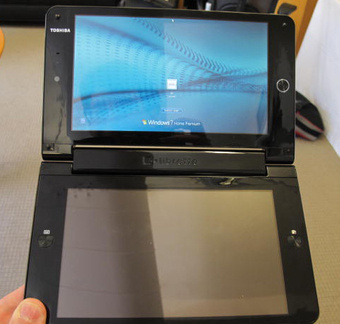
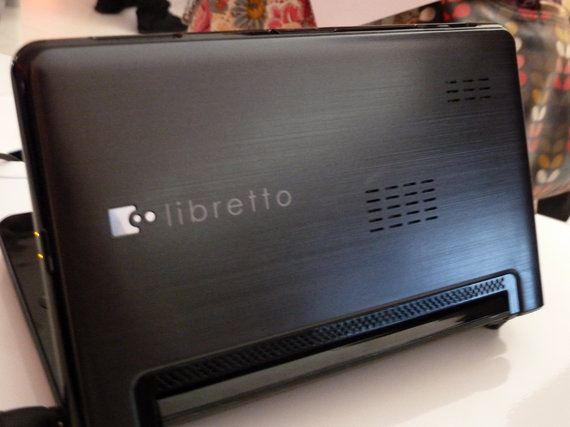




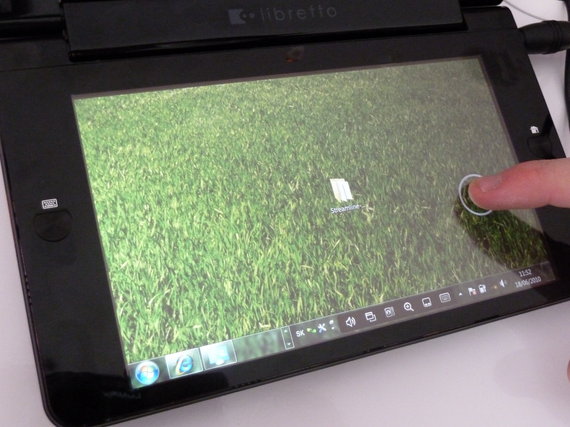

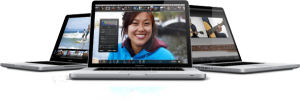
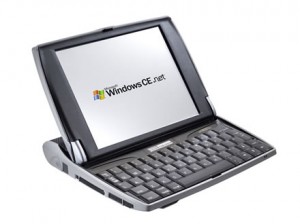
Pingback: gawq
Pingback: gbsde